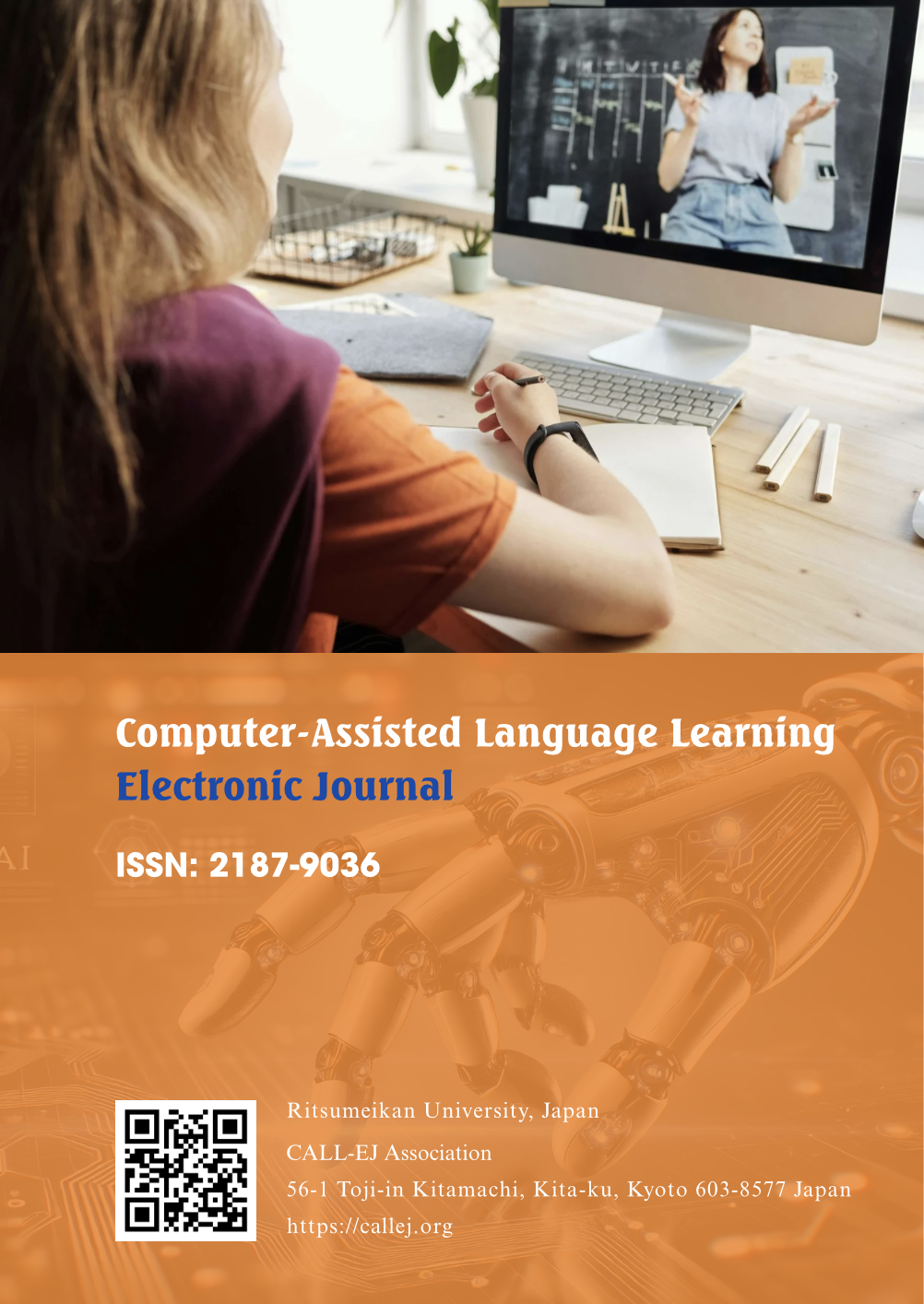Abstract
Globalization has resulted in educational and commercial groups requiring their mentors and mentees to have an international outlook and be interculturally aware. Teachers of English as a Foreign Language (EFL) students are often assigned the task of ensuring students are attuned to this fact and encouraged to bring intercultural training into their classrooms. Acclimatizing students to intercultural contact with international peers is now possible in foreign language classrooms. This study examines Indonesian students’ intercultural presence through an international Virtual Exchange (VE) being integrated into their university EFL course. The study is longitudinal as it followed a classroom, and the different participants therein, over a three-year period. A post-survey was used that included qualitative and quantitative data collection through Likert scale and open-ended questions. The surveys evince a deeper understanding of the students’ perspective of, and reactions to, their intercultural presence in the VE. Results were analyzed with mean scores and standard deviations of the Likert scales calculated and thematic analysis of the answers to the open-ended questions. Despite some challenges, results show students had a positive impression of participating in an international community of inquiry through the VE and appreciated its effect on their English language and intercultural competence development.
References
Baker, W. (2012). From cultural awareness to intercultural awareness: Culture in ELT. ELT Journal, 66(1), 62–70. https://doi.org/10.1093/elt/ccr017
Belz, J. A. (2007). The development of intercultural communicative competence in telecollaborative partnerships. In R. O’Dowd (Ed.), Online intercultural exchange: An introduction for foreign language teachers (pp. 127-166). Multilingual Matters.
Canals, L. (2020). The effects of virtual exchanges on oral skills and motivation. Language Learning & Technology, 24(3), 103-119. http://hdl.handle.net/10125/44742
Choi, J.W. (2008). The role of online collaboration in promoting ESL writing. English Language Teaching, 1(1), 34-49 https://ccsenet.org/journal/index.php/elt/article/download/508/490
Garrison, D. R., Anderson, T. & Archer, W. (1999). Critical inquiry in a text-based environment: computer conferencing in higher education. The Internet and Higher Education, 2, (2-3), 87–105. https://doi.org/10.1016/S1096-7516(00)00016-6
Gay, L.R., Mills, G.E., and Airasian, P.W. (2011). Educational Research: Competencies for analysis and applications (tenth edition). Pearson Education Inc.
Godwin-Jones, R. (2019). Telecollaboration as an approach to developing intercultural communication competence. Language Learning & Technology, 23(3), 8-28. http://hdl.handle.net/10125/44691
Hagley, E. (2020a). Musings on virtual exchange in the Asia-Pacific and beyond. In Hagley, Eric; Wang, Yi’an (Eds.), Virtual exchange in the Asia-Pacific: research and practice (pp. 231-240). Research-publishing.net. https://doi.org/10.14705/rpnet.2020.47.1154
Hagley, E. (2020b). Effects of virtual exchange in the EFL classroom on students' cultural and intercultural sensitivity. Computer-Assisted Language Learning Electronic Journal, 21(3), 74-87. http://callej.org/journal/21-3/Hagley2020.pdf
Hagley, E. (2021). Incorporating the International Virtual Exchange Project into English Curricula in Japan – Benefits and Issues. Bulletin of Research Center for Computing and Multimedia Studies, Hosei University, 36, 47-53. https://doi.org/10.34368/rccms.36.0_47
Hagley, E. (2023). Bringing ELF to life via Virtual Exchange –The IVEProject, In Stevkovska, M., Idrizi, E., and Miftari-Fetishi, I. (Eds). Contemporary Issues in Language Teaching, (pp. 63-80), International Balkan University. https://www.researchgate.net/publication/369361904_Virtual_Exchange_Bringing_ELF_to_life
Hauck, M. (2019). Virtual exchange for (critical) digital literacy skills development. European Journal of Language Policy, 11(2), https://doi.org/10.3828/ejlp.2019.12.
Helm, F. (2018). Emerging identities in virtual exchange, Research-publishing.net https://files.eric.ed.gov/fulltext/ED585082.pdf
Hřebačková, M. (2019). Teaching Intercultural Communicative Competence Through Virtual Exchange. Training, Language and Culture, 3(4), 8-17. doi: 10.29366/2019tlc.3.4.1
Keidanren survey, (2018). (Japanese only) http://www.keidanren.or.jp/policy/2018/029_kekka.pdf
Kohn, K & Hoffstaedter, P. (2017). Learner Agency and Non-Native Speaker Identity in Pedagogical Lingua Franca Conversations: Insights from Intercultural Telecollaboration in Foreign Language Education, Computer Assisted Language Learning, 30(5), 351-367, https://doi.org/10.1080/09588221.2017.1304966
Latifa, A. (2021). The Attitude of Indonesian Learners in Tertiary Level toward Spoken English and its Learning. Journal of World Englishes and Educational Practices, 3(2), 01–09. https://doi.org/10.32996/jweep.2021.3.2.1
Mambu, J. E. (2018). Critical pedagogy in the ELF era: An Indonesian-based English language teacher educator’s reflection. In S. Zein (Ed.), Teacher education for English as a lingua franca: Perspectives from Indonesia (pp. 41–57). Routledge.
Murtisari, E. T., & Mali, Y. C. (2017). Impact of English on the Indonesian language and culture: High school students’ perceptions. Studies about Languages, 30, 90–104. https://doi.org/10.5755/j01.sal.0.30.17570
Roarty, A. & Hagley, E. (2021). Using virtual exchange to develop intercultural understanding in EFL students. Teaching English as a Second Language Electronic Journal (TESL-EJ), 25(3). https://tesl-ej.org/pdf/ej99/a14.pdf
Roarty, A., Tuncer, H., Tang, L., (2023). Adding synchronous sessions to asynchronous virtual exchange: Insights from the IVEProject. Intercultural Communication Education, 6(1), 19–32. doi.org/10.29140/ice.v6n1.760
Ryan, R. M., & Deci, E. L. (2020). Intrinsic and extrinsic motivation from a self-determination theory perspective: Definitions, theory, practices, and future directions. Contemporary Educational Psychology, 61, 101860. https://doi.org/10.1016/j.cedpsych.2020.101860
Schenker, T. (2013). The effects of a virtual exchange on students’ interest in learning about culture, Foreign Language Annals, 46(3), 491–507.
Simbolon, N. E. (2021). English Medium Instruction (EMI) practice: Higher education internationalization in Indonesia. Englisia: Journal of Language, Education, and Humanities, 8(2), 72-83. https://doi.org/10.22373/ej.v8i2.8961
Thomas, D. R. (2006). A General Inductive Approach for Analyzing Qualitative Evaluation Data. American Journal of Evaluation, 27(2), 237-246. https://doi.org/10.1177/1098214005283748
Zein, S., Sukyadi, D., Hamied, F. A., & Lengkanawati, N. S. (2020). English language education in Indonesia: A review of research (2011–2019). Language Teaching 53(4), 491–523. doi:10.1017/S0261444820000208
Zhou, A. (2023). Investigating the impact of online language exchanges on second language speaking and willingness to communicate of Chinese EFL learners: a mixed methods study. Frontiers in Psychology, 14, https://www.frontiersin.org/articles/10.3389/fpsyg.2023.1177922

This work is licensed under a Creative Commons Attribution 4.0 International License.
Copyright (c) 2025 Author and CALL-EJ

